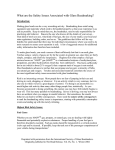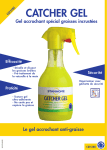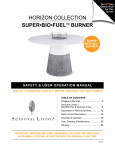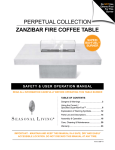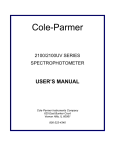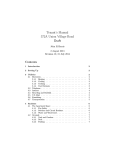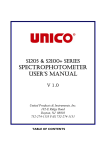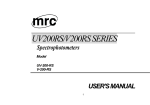Download Fireworks Bead Making Kit Manual - The Avenue Stained Glass Studio
Transcript
Beginners Beadmaking Kit Instructional Manual A beadmaking class from a skilled professional can be very beneficial to improving your skills. For a listing of instructors near you visit the International Glass Bead Society’s website at www.isgb.org CAUTION: Kit uses flammable gas and open flame. Adult supervision required. Not for use by children under 15 years of age. Tampa, FL • 800-937-9593 • 813-806-2923 • Fax: 813-806-1988 Safety Instructions Please read and follow instructions completely before beginning. When working with glass, protect your feet and legs by wearing pants and closed top shoes. Eye protection is essential. Cold glass, when heated too quickly, may fragment off. Always wear eye protective gear to shield yourself from possible hazardous glass projectiles. Use caution while working with hot torch and glass to ensure proper and safe use. Otherwise, severe burns can occur. Work area should be free from curtains or other combustible materials. Make sure work area is also well ventilated. Keep a fire extiguisher handy in your work area for emergency purposes. Kit Contents 1. Fiber Blanket-Used to slowly cool completed bead. 2. Bottle Holder-Fireworks bottle holder assembly clamps on the edge of any table to hold the MAPP Gas tank securely in place without slipping. 3. Bead Release-A thick liquid coating that prevents glass from sticking to metal. 4. Fireworks Torch Designed exclusively for Fireworks, this unique torch head has a self- igniting system for easy use. 10 1 3 4 8 9 CAUTION: Do not store with torch attached to fuel tank. 7 2 5 6 5. Rake-Use rake to manipulate molten glass by dragging, raking, feathering or swirling the surface. It can be used to make air bubbles inside the bead or poke holes through the glass. Fireworks rake has a bent tip for a comfort grip. 6. Mandrels-Stainless steel rods used to wrap molten glass around to create a bead. They have a low heat transfer, keeping your fingers cool while working in direct open flame. 7. Glass Rods-Your kit contains an assortment of translucent and opaque Italian glass rods. They are 104 COE and heat evenly and quickly in the torch flame. 8. Scrubber-Helps to remove bead and mandrel release residue. 9. Marver - Roll or press your glass into the ridges of this 2” x 4” textured surface to make interesting patterns. Experiment by rolling bead at different angles. Warm marver before using by holding 6” from flame for approximately 15 seconds. 10. Heat Resistant Work Surface-Protects your table or counter top. Additional items not found in Beginners Kit: Methyl Acetylene Propadiene (MAPP) Gas, commonly found in most hardware stores; Protective Didymium Glasses (for more details on protective eyewear contact www.auralens.com) Setting Up Remove all components from kit and packaging. Place heat resistant work surface on counter or table top. Place all tools on work surface for easy access. Keep a fire extiguisher handy in your work area for emergency purposes. Prepare mandrels by quickly dipping them into mandrel release, 2”-3” deep and twirl out to insure a thin, clean, even coating. Secure upright and allow to air dry 15-20 minutes or dry mandrels slowly in the flame. Mandrel are dry when they turn a light gray. Mandrel release must dry completely before use. Before attaching torch head to the MAPP Gas tank; make sure valve is completely closed by turning it clockwise. Next, screw threaded opening onto the tank. Secure the tank to the edge of table or counter top, using the enclosed bottle holder attachment. Wrap bottle band around MAPP tank and insert “L” bracket between the tank and the band. Using a screwdriver, tighten the locking screw until snug. Position tank so one arm of the “L” bracket is on the table top, secure to the table using the “C” clamp (Fig. 1). The torch head should be directed away from you. Igniting Torch The source of heat is the MAPP Gas tank and torch head. Ignite torch by turning the control valve at the rear of torch head slowly counter clockwise, releasing gas. When you hear a slight hissing sound, gently squeeze trigger. Adjust flame height with the control valve knob, providing a “blue” flame length of 1” and adjust the airflow opening to regulate gas to air mix. Turn off torch by turning control valve clockwise, until flame is exhausted. Do not attempt to handle torch head until it has sufficiently cooled down. Fig. 1 Fig. 2 Fig. 3 Basic Bead Technique Begin by warming a glass rod in the flame. (Fig. 2) NOTE: Wear safety glasses. Starting 3”-4” from flame, gradually bring the tip of the glass towards the blue flame. Work glass in flame until a hot molten ball forms. In your second hand, warm your coated mandrel using the same procedure used to warm the glass rod. (Fig. 3) When molten and glowing, wrap glass evenly around heated mandrel. While rolling the mandrel away from you, drape glass on mandrel from the top Fig. 4 down. Do not pull cool glass. Pulling glass may remove mandrel release resulting in residue inside your finished bead. Heat more glass as you roll. When sufficient glass is wrapped on mandrel, separate glass rod from bead by directing heat to the joint and pulling away. Place glass rod on work surface to cool. (Fig. 4) Continuously roll the mandrel with your bead in the flame to shape. Using the smooth surface of the marver, briefly take the bead out of the flame and roll on marver paddle surface to shape your base bead. Bead will cool and start to harden upon contact with marver. When this occurs, place bead back into flame to soften and roll again on marver until desired shape. Fig. 5 To increase bead size or to add another color, begin by heating another glass rod. (Fig. 5) Keep the base bead warm near flame while heating the glass rod (Fig. 2). Once the glass glob is molten, add to the base bead. Turn Fig. 6 mandrel, as in Fig. 3, adding glass until you are satisfied with the size and shape of the bead. Bead should not be larger than 10mm in diameter to prevent cracking during cooling. Keep rolling mandrel in flame until a well balanced bead is formed, using the marver as desired. Holding the bead at an angle, roll against the marver edge to bevel the end. If glass becomes too hard to shape, return bead to the flame to soften glass. Cool Down Cool bead by removing it slowly from the flame and allowing the red glow to disappear, 10-15 seconds (Fig. 6). Place bead and mandrel between the layers of the fiber blanket to cool. Do not remove the beaded mandrel from the blanket for 60-90 minutes to allow sufficient cooling to take place. If not, your bead may crack. After bead has cooled, remove from mandrel. Place bead and mandrel in a cup of water and using a green scrubby, turn the mandrel to loosen. If bead cannot be removed easily, use a plier to grab the mandrel below the bead and twist off. The bead release residue will flake away as you slide the bead off. If the bead is difficult to remove, soak in water. Don’t be discouraged by a poorly developed first bead, success comes with practice. So keep on rolling! Tool Care Instructions Proper bead making technique is to heat glass in the flame while working in direct heat with the tools. If a tool is used to hold hot glass, make sure it is not placed directly in the flame. Hot metal tools will stick to glass. If you are using a tool to hold glass, you want the metal warm, but not hot. It is acceptable to warm a metal tool by quickly placing it near the flame. If you are using a metal tool to poke, scrape or rake the glass, they should be as cool as possible. If it becomes too hot, switch it with a backup tool or immerse the metal tool in water to cool it down.




